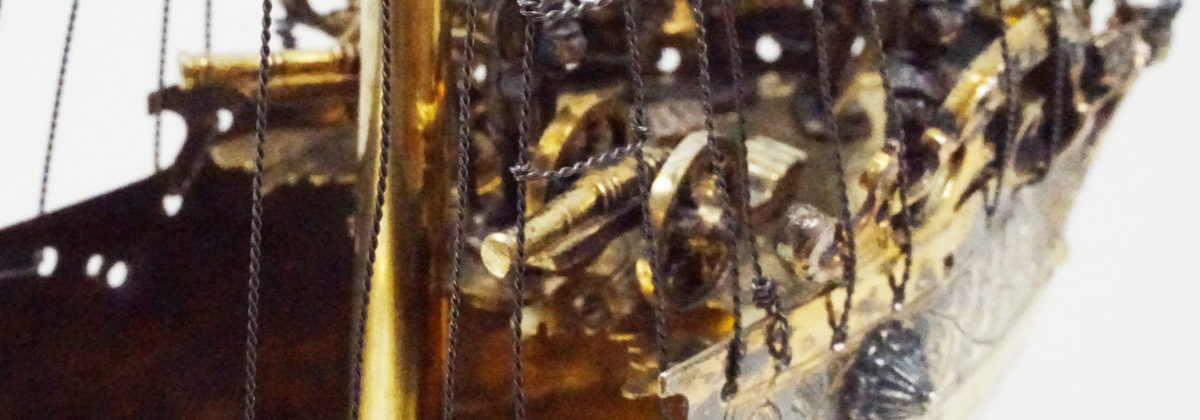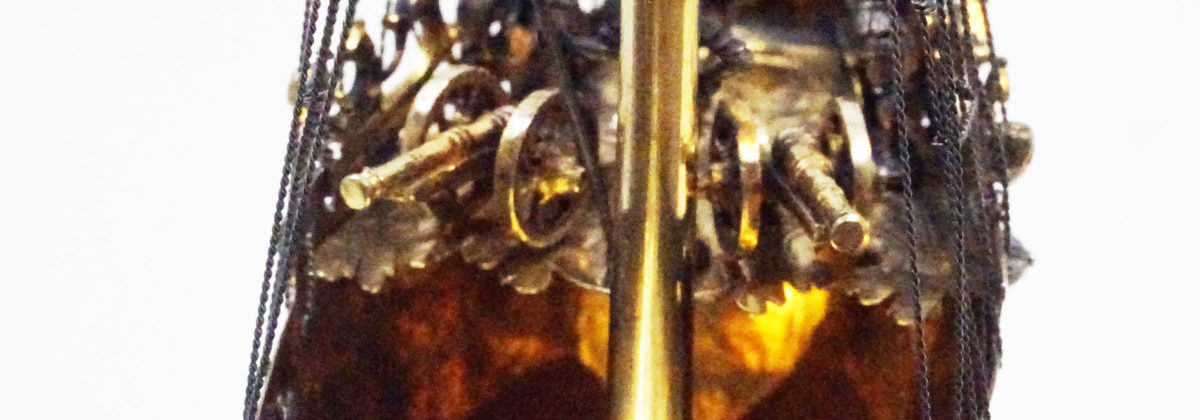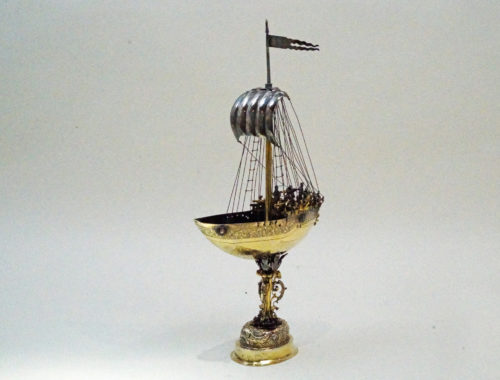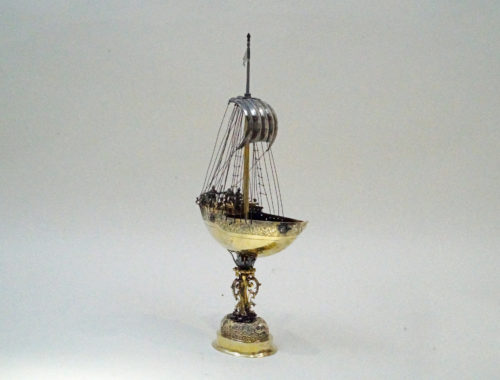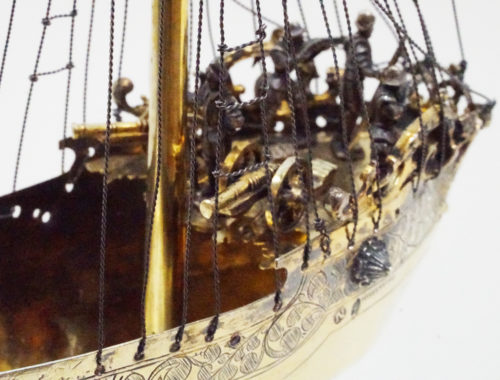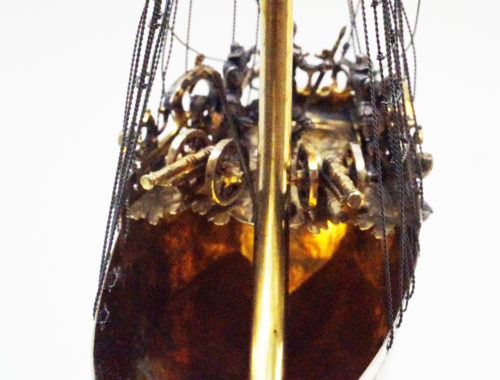Object number :
Nuremberg, around 1620–1629
Esaias zur Linden
H 37.5 cm; 440 g
Provenance: In the hands of a Swiss family without interruption since the 1920s.
Fitted with a mast, at the top a billowed sail, above a lance-shaped rod with a pennant, four warriors on the quarterdeck as well as two heavy cannons, on a highly arched foot, driven by dolphins in the water.
The underside engraved with Cyrillic inscriptions, assessment (1609–1629) and master mark as well as tremble engraving on the ship, master mark on the foot. A control mark on the pennant. A very similar cup is in the collection of the Armoury
Such magnificently designed silver drinking vessels were considered a special highlight of early modern drinking culture. Used to present status at court, whilst also being popular from the princely court to the patriciate of the leading imperial cities. Placed in a prominent position in front of the guest of honor at the table, it served to fascinate and amuse the assembled dining party.
Designed to function such that the ship’s belly was filled with liquid, and drunk though the drinking tuber at the ships bow. The drinker faced the challenge of dodging the defensive lance of the “Moor”, designed such as to protrude directly at the nose of the brave drinking companion. The delicate volute clasp on the stern served as a handle for the drinking vessel, which had to be lifted to drink.
Nuremberg drinking vessels and their spread
Table ships have been used at princely courts as table decorations or showpieces on buffets since the 14th century. Drinking vessels from Nuremberg have been known since the beginning of the 16th century. They were particularly fashionable in the first half of the 17th century. Some Nuremberg goldsmiths, in particular Georg Müllner, Tobias Wolff and Esaias zur Linden, specialised in the manufacture of these elaborate goblets to meet the high demand for the elaborately decorated drinking games. However, no other master was as prolific in this profession as Esaias zur Linden: the present table ship – like many other ship goblets and drinking ships on wheels – was made by the well-known goldsmith master.
Historical context
In medieval France vessels in the shape of a ship were used to store wine, spices and and as drinking cups for lords. Spiking drinks was a relatively common act in the Middle Ages, thereby using such ships assisted in assuring the Lord/drinker that their food and drink were free of poison. Ship-shaped implements were also used in a religious context (e.g., as a censer). These served as a symbol of the Church and of God for man’s salvation. There are also reports of ships being made from silver and other precious materials, which were brought to the church as votive offerings for a safe return from a perilous voyage. For example, Margaret of Provence (1221-1295), a nef of the church of Saint-Nicolas in Saint-Nicolas-de-Port in Lorraine, donated in 1254 as a token of her gratitude for the safe return of her family. In the German cultural area and in Central and Western Europe, ships have been known as drinking vessels or centerpieces since the early 16th century. On the occasion of the marriage of Wilhelm V of Bavaria to Renata of Lorraine in 1568, there were 20 salt vessels in the form of ships, all silver or silver gilded (Lehne 1985: 84). According to the latest research, they were also used as salt and spice vessels in the 17th century. The decoration of a table is certainly in the foreground when hosting a dinner, thereby such ships were placed near the most important guest at the table. Ships that do not have a spout or drinking tube served as salt vessels or were intended to represent the transport of salt, as a new archival report from Gdańsk proves. Vessels were a status symbol and were meant to symbolize the importance of a particular guest at the table. In addition, the ship is considered a symbol of a fulfilled and long life. As great centers of goldsmithing in southern Germany, Augsburg and Nuremberg also specialised in the manufacture of ships. Ships should also be considered in connection with the popularity and variety of table fountains in the 16th and 17th centuries (see Wiewelhove, 2002, pp. 91-2). The imagination and artistic/craftsmanship of the Augsburg and Nuremberg masters unfolded masterfully in this period through the manufacture of table and puzzle devices. In general, such ships were not replicas of existing ships. Rather, these were evidence of the creative imagination of the master, who used existing designs of ships – contemporary or even older – as models. Nefs were very popular luxury vessels up until the late 19th century and were often given as exceptional gifts. A very fine, historically important example in the musée des arts décoratifs in Paris shows the symbolic power of ships. For the goldsmiths in southern Germany, the key field ship (ca. 1503) (in the Germanic National Museum, Nuremberg) was probably a constant reference. This, however, was a vessel clearly made for drinking. Similar to the key fields ship, the master of the present ship has chosen to show an alarming scene in the everyday life of the ship. The ship’s crew is highly concentrated on the deck and looks into the distance. The ship represents an important moment in his life at sea. This should give the guests at a dinner an opportunity to talk about the symbolism of the ship, its origin and the craftsmanship of the master.
Maker:
The goldsmith Esaias zur Linden learnt the goldsmith’s trade from 1593 with Hans Peter Rahn, a goldsmith from Zurich. He received citizenship in Zurich in 1607 and completed the master’s examination in 1609. As early as 1610 he was able to afford the increased fees for newcomers to acquire citizenship in Nuremberg and worked in the imperial city of Nuremberg until his death in 1632.
Between 1610 and his death in 1632, Esaias zur Linden created more than 60 ship goblets and drinking vessels on wheels, tankards and credenzas, the setting of two rock crystal goblets, a rhinoceros horn bowl and several grape goblets.
Zur Linden’s table ships achieved world fame and are now in renowned museums such as the Metropolitan Museum in New York, the Nationalmuseet Copenhagen, the Hermitage St. Petersburg, the armory of the Moscow Kremlin, the Victoria & Albert Museum in London, the Landesmuseum Württemberg in Stuttgart, the Krakauer Wawel, the Bielefeld arts and crafts collection – Hülsmann Foundation, the Swiss National Museum in Zurich (also with cold enamel), the Applied Arts collection, Kassel museum landscape hesse kassel (with cold enamel), the Kunsthistorisches Museum in Vienna, and other important collections.
collection, exhibition in the Basel Historical Museum, Basel 2022, pp. 80-85 ( on Nuremberg drinking vessels), esp. cat. no. 213 (Esaias zur Linden)




